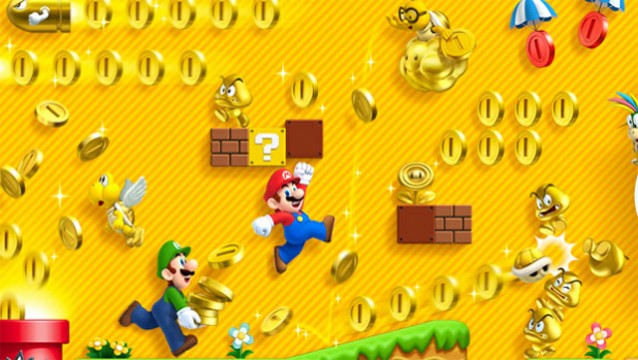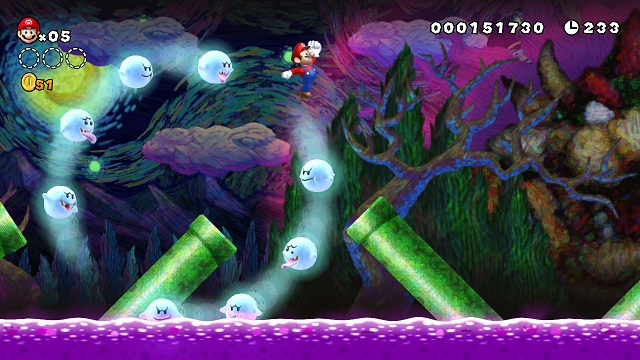
As someone who grew up in the ’90s, when games were first diving into the untouched realm of 3D, it was easy to imagine a world where 2D games would simply become a thing of the past. Games like Super Mario 64 opened up so many possibilities that the idea of returning to sidescrollers was simply unthinkable!
But even with increasingly powerful graphics processors and games like Skyrim, which let you explore fully realised open-worlds, 2D games remain incredibly popular. In fact, for a large number of gamers, they are actually preferable to a number of flashier alternatives.
One of the main reasons behind this, and one that Nintendo completely understands, is that 2D games are inherently more accessible. Despite the excellent Super Mario Galaxy games, and more recent Super Mario 3D World, which all introduced fresh and exciting ideas, they were outsold by the New Super Mario Bros. games. In fact, New Super Mario Bros. Wii outsold both Galaxy and Galaxy 2 put together. It certainly seems like the more accessible nature of the “New” series appeals to families, and this undoubtedly plays a part in their high sales figures. Indeed, 2D games are generally easier to play for the casual or younger gamer. Problems relating to camera control, for example, have plagued 3D games from the onset, but have little impact on 2D games, which have little need for any such features (or a second analogue stick in fact). It certainly makes 2D gaming less cumbersome at any rate, and as someone who has tried explaining how to move in a FFS game to a non-gamer, this alone completely simplifies the experience!

But the simple fact that 2D games can be more accessible doesn’t necessarily mean that they are easier. In fact, the thumb-blisteringly difficult memories associated with old school 2D platformers live on in a number of modern 2D games. Games like Super Meat Boy and Mutant Mudds aren’t easy in any sense of the word– even if the controls can be immediately understood. This nostalgic element is another factor which draws people to these sorts of games and has seen a resurgence in recent years. The 3DS and Wii U game Shovel Knight combines elements from a number of classic games, like Mega Man, DuckTales, Castlevania, and more, yet it still stands apart from these games thanks to its distinct (though clearly retro inspired) art style, plot, and gameplay.
In fact, while a number of large 3D games are routinely accused of retreading similar ground, 2D games increasingly feature interesting and varied art design, gameplay twists, and more. That’s not to say that this is universally true– I personally believe that the New Super Mario Bros. series could do with shaking up the formula, for instance– but perhaps because of the limits of 2D gameplay, developers have to rethink how they present this sort of game.
Shovel Knight is an example of a retro-inspired game that was injected with fresh ideas, but this sort of creativity is seeping into so many 2D games at the moment. In Nintendo’s Kirby’s Epic Yarn , simply changing the world to one made of fabric had a huge impact on gameplay and made the game utterly unique. The art style of the game was so popular that a similar style has been used for the upcoming Yoshi’s Woolly World, a similarly cloth-based take on the typical Yoshi gameplay.
Child of Light, another recent and creative 2D game, combines great combat, a beautiful art style, and a surprising array of characters. For me, it exemplifies what sort of experience is possible in a modern 2D game. In fact, games such as Rayman Origins and Legends have shown that the future of any series does not necessarily lie in a shift to 3D– an idea that the Sonic series constantly battles with.

Despite what we gamers may have thought then at the start of the 21st century, 2D games continue to be a popular and creative style of game, even alongside impressive Hollywood blockbusters and 3D powerhouses. In fact, whether they adopt cell-shaded, retro, or 2.5D graphics, 2D games can look just as good as any 3D game, and while I haven’t had the chance to delve into areas like fighting games, where 2D variants are in fact more popular than 3D series’, it is fair to say that 2D games remain prevalent in a number of genres.
The fact that so many of Nintendo’s franchises continue to be released in the form of 2D platformers, such as Mario, Donkey Kong, Kirby, and Yoshi, shows just how popular that sort of gameplay still is. That these are supported by an increasing number of indie games, with ideas which are equally creative (if not more so), means that there will be no shortage of games with this style of gameplay in the near future. This should come as a relief for those gamers who aren’t quite able to use both the left and right analogue sticks at once!




 ShareThis
ShareThis







It’s very interesting how, for a good stretch, 2D was simply seen as a spring board for what would become 3D games; that it was something to be left behind. Thank goodness for Nintendo, indie devs, and even Sony (LittleBigPlanet!) for helping the genre make a comeback.